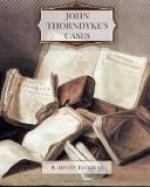“As to the latter,” said Thorndyke, “it is probable that he used a compressed-air attachment, not only to diminish the noise, but also to prevent any traces of the explosive from being left on the dagger. As to the former, I think I can give you the murderer’s name; but we had better take the evidence in order. You may remember,” he continued, “that when Dr. Jervis stood as if winding the clock, I chalked a mark on the floor where he stood. Now, standing on that marked spot, and looking out of the open window, I could see two of the windows of a house nearly opposite. They were the second- and third-floor windows of No. 6, Cotman Street. The second-floor is occupied by a firm of architects; the third-floor by a commission agent named Thomas Barlow. I called on Mr. Barlow, but before describing my visit, I will refer to another matter. You haven’t those threatening letters about you, I suppose?”
“Yes, I have,” said the inspector; and he drew forth a wallet from his breast-pocket.
“Lot us take the first one, then,” said Thorndyke. “You see that the paper and envelope are of the very commonest, and the writing illiterate. But the ink does not agree with this. Illiterate people usually buy their ink in penny bottles. Now, this envelope is addressed with Draper’s dichroic ink—a superior office ink, sold only in large bottles—and the red ink in which the note is written is an unfixed, scarlet ink, such as is used by draughtsmen, and has been used, as you can see, in a stylographic pen. But the most interesting thing about this letter is the design drawn at the top. In an artistic sense, the man could not draw, and the anatomical details of the skull are ridiculous. Yet the drawing is very neat. It has the clean, wiry line of a machine drawing, and is done with a steady, practised hand. It is also perfectly symmetrical; the skull, for instance, is exactly in the centre, and, when we examine it through a lens, we see why it is so, for we discover traces of a pencilled centre-line and ruled cross-lines. Moreover, the lens reveals a tiny particle of draughtsman’s soft, red, rubber, with which the pencil lines were taken out; and all these facts, taken together, suggest that the drawing was made by someone accustomed to making accurate mechanical drawings. And now we will return to Mr. Barlow. He was out when I called, but I took the liberty of glancing round the office, and this is what I saw. On the mantelshelf was a twelve-inch flat boxwood rule, such as engineers use, a piece of soft, red rubber, and a stone bottle of Draper’s dichroic ink. I obtained, by a simple ruse, a specimen of the office notepaper and the ink. We will examine it presently. I found that Mr. Barlow is a new tenant, that he is rather short, wears a wig and spectacles, and always wears a glove on his left hand. He left the office at 8.30 this morning, and no one saw him arrive. He had with him a square case, and a narrow, oblong one about five feet in length; and he took a cab to Victoria, and apparently caught the 8.51 train to Chatham.”




